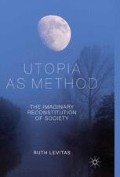Abstract
Utopia as architecture is its culturally most familiar mode: imagining a reconstructed world and describing its social institutions. This is the terrain of utopian fiction. It is also the mode anti-utopians like best, keeping the possibility of living differently safely bound between book covers. As we have seen in Part I, the expression of utopian desire cannot be confined in this way but leaks into every aspect of human culture. Utopia as architecture incorporates the ontological mode, positing inhabitants who feel and want, as well as behave, differently from ourselves. Therein lies the education of desire. The balance between institutional and ontological concerns varies. This final chapter addresses the social forms demanded by the principles of dignity and grace outlined in Chapter 9, keeping in view the self-creating and institution-creating capacities of human beings.
Access this chapter
Tax calculation will be finalised at checkout
Purchases are for personal use only
Preview
Unable to display preview. Download preview PDF.
Notes
M. D. Higgins (2011) Renewing the Republic (Dublin: Liberties Press) pp. 95–6.
K. Marx and F. Engels (1848) ‘The Manifesto of the Communist Party’, in K. Marx and F. Engels (1968) Selected Works (London: Lawrence and Wishart) p. 53.
Cited in J. Beecher and R. Bienvenu (eds) (1983) The Utopian Vision of Charles Fourier: Selected Texts on Work, Love and Passionate Attraction (Columbia: University of Missouri Press) p. 30.
A. Bammer (1991) Partial Visions (London: Routledge) p. 126.
B. Russell (1932) In Praise of Idleness, http://www.zpub.com/notes/idle.html, accessed 11 September 2012.
D. Harvey (2010) The Enigma of Capital (London: Profile) p. 225.
A. Gorz (1999) Reclaiming Work (Cambridge: Polity) p. 54.
R. Sennett (2008) The Craftsman (London: Penguin).
A. Sayer (2011) Why Things Matter to People: Social Science, Values and Ethical Life (Cambridge: Cambridge University Press) p. 214.
M. Glucksmann (1995) ‘Why “Work”? Gender and the “Total Social Organization of Labour”’, Gender Work and Organization, 2(2): 63–75.
P. Seeger (1958) ‘Oh, Had I a Golden Thread’, http://www.peteseeger.net/goldthred.htm, accessed 9 September 2012.
A. Meyer (2000) Contraction and Convergence: The Global Solution to Climate Change (Totnes: Green Books) p. 12.
UNDP (United Nations Development Programme) (1999) Human Development Report 1999, (New York: United Nations), p. 36;
UNDP (2009) Human Development Report (New York: United Nations) p. 35.
P. Townsend (1993) ‘Closing Remarks at a Celebration to Mark a Retirement from the University of Bristol’, Excerpted in Peter Townsend 1928–2009 (Bristol: The Policy Press) 2009, p. 16.
P. Townsend (2002) ‘Poverty, Social Exclusion and Social Polarisation: The Need to Construct an International Welfare State’, in Peter Townsend and David Gordon (eds) World Poverty: New Policies to Defeat an Old Enemy (Bristol: The Policy Press) pp. 3–24.
N. Coleman (2005) Utopias and Architecture (London: Routledge).
R. Unger (2007) The Self Awakened: Pragmatism Unbound (Cambridge, MA: Harvard University Press) p. 117.
W. Morris (1894) How I Became a Socialist, http://www.marxists.org/archive/ morris/works/1894/hibs/index.htm, accessed 9 September 2012.
F. Jameson (1988) Brecht on Method (London: Verso 1998).
W. Morris (1907) A Dream of John Ball and A King’s Lesson (London: Longmans, Green and Co.) [1886] p. 36.
E. Bloch (2000) The Spirit of Utopia (Stanford: Stanford California Press) p. 3.
Author information
Authors and Affiliations
Copyright information
© 2013 Ruth Levitas
About this chapter
Cite this chapter
Levitas, R. (2013). Utopia as Architecture. In: Utopia as Method. Palgrave Macmillan, London. https://doi.org/10.1057/9781137314253_10
Download citation
DOI: https://doi.org/10.1057/9781137314253_10
Publisher Name: Palgrave Macmillan, London
Print ISBN: 978-0-230-23197-9
Online ISBN: 978-1-137-31425-3
eBook Packages: Palgrave Social Sciences CollectionSocial Sciences (R0)

